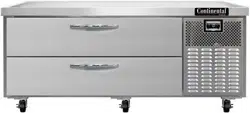Loading ...
Loading ...
Loading ...

19
OPERATIONS MANUAL
REFRIGERATED GRIDDLE STANDS
3. No refrigeration component, tubing or fitting shall be left
open to the atmosphere for more than ½ hour without
being soldered, capped or plugged.
4. Each completed refrigeration system shall be purged with
150psi of dry nitrogen for at least six (6) seconds, then
pressurized with at least 165psi of nitrogen for pressure
check (making sure to energize any solenoid valves to
assure access). Leak-check all joints, flare fittings and
valves and make sure there is no pressure drop within the
system.
5. System evacuation is of the utmost importance with NON-
CFC refrigerant systems. System must be evacuated to a
minimum of 200 microns. In addition, a vacuum decay
test is strongly recommended to assure there is not a
large pressure differential between the system and vacuum
pump. System must be evacuated from both high and low
sides of the system using heavy duty vacuum hoses.
6. Each system should be charged with the refrigerant type
as specified on the cabinet data tag. This refrigerant type
should match the type listed on the condensing unit being
used. The refrigerant charge should be held to the mini-
mum required for the satisfactory pull down and opera-
tion. For an accurate indication of refrigerant charge, the
sight glass will show a full column of liquid.
7. The superheat reading taken 6” from the compressor suc-
tion valve should be 30° +/- 5°. Expansion valve adjust-
ment may be necessary to achieve this superheat.
8. Installation of the electric condensate vaporizer is also
the responsibility of the installer (see “Installing Electric
Condensate Vaporizer” under “Optional Accessories”).
CAUTION: EXTREME CARE MUST BE USED WHEN
ACCESSING THE SYSTEM DURING INSTALLATION. DUE
TO THE COMPLEXITY OF REMOTE REFRIGERATION
SYSTEMS AND THE POTENTIAL FOR IMPROPER
INSTALLATION, ANY RESTRICTIONS, LEAKS, FAILED OR
DAMAGED COMPONENTS CAUSED BY CONTAMINANTS
ARE NOT THE RESPONSIBILITY OF CONTINENTAL
REFRIGERATOR.
REMOTE SET-UP AND INSTALLATION GUIDELINES
All remote refrigerators and freezers are shipped with an expan-
sion valve, thermostat, solenoid valve and defrost timer installed
from the factory. The installer is responsible for installing
electric condensate vaporizer, connecting all refrigerant lines,
liquid line drier, sight glass, solenoid, head pressure control, hi/
low pressure safety, crankcase heater, condensing unit and any
other accessories as well as wiring. The evaporator section has
been factory leak checked with helium, however; due to vibration
in transit, the entire system must be thoroughly leak checked
after installation and prior to start-up. The final leak inspection
of the entire completed refrigeration system and all of its com-
ponents as well as start-up and the operation of the refrigeration
system is the sole responsibility of the installer.
The CFC-Free refrigerant used in standard remote and self-con-
tained models is R-134a for refrigerators and R-404a for freez-
ers and CPT models. All compressors and systems designed
for these refrigerant utilize polyolester oil as their main lubri-
cant, which absorbs moisture from the ambient surroundings
extremely fast and in much greater quantity than conventional
mineral oils. Since moisture levels greater than 100 PPM will
result in system corrosion and ultimate failure, it is imperative
that the compressor, components and entire system be kept
sealed.
1. All refrigerant lines and components must be clean, free of
burrs and purged with nitrogen prior to and during brazing
or soldering connections. Nitrogen purging during braz-
ing or soldering will eliminate carbon or foreign matter
contamination. Any system restrictions or contamination is
the responsibility of the installer.
2. Condensing unit or compressor shall not be left open to
the atmosphere for more than five (5) minutes.
FIGURE 9: Leg Installation
A
LEG
LEG INSTALLATION
BLOCKS
THREADED
END
TURN FOOT CLOCKWISE
TO REDUCE HEIGHT, OR
COUNTERCLOCKWISE
TO INCREASE HEIGHT.
Loading ...
Loading ...
Loading ...
